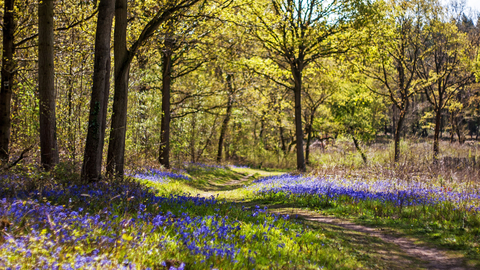Please keep dogs on a lead and keep to designated paths at all times. Thank you.

Tiddesley Wood by Paul Lane
Tiddesley Wood - the Harry Green Reserve
Know before you go
Dogs
When to visit
Opening times
Dawn to duskBest time to visit
All year roundAbout the reserve
This large woodland was once an enclosed deer park and was previously owned by the Abbots of Pershore Abbey and local nobility as well as the Forestry Commission. The Forestry Commission managed much of the wood as a commercial forestry plantation in the 1950s. The Trust bought the wood because of its outstanding importance as an ancient woodland with the ultimate aim of restoring it to its former condition.
We manage the wood using a variety of forestry techniques. Our coppice plots are carpeted with wildflowers in spring – bluebells, wood anemones, violets and cowslips. Coppicing trees involves cutting them back almost to ground level. This encourages new growth and, when done in rotation, ensures a diverse range of habitats through different stages of growth. Coppiced areas are great for butterflies, insects and warblers.
The larger trees provide habitats for insects that need mature and dead wood. In these shadier areas visitors should look for uncommon violet helleborines and, where some light penetrates, herb paris, greater butterfly orchid, twayblade and dog’s mercury. The conifer plantations are gradually being converted to broad-leaved woodland and provide a contrast to oak, ash, aspen, hazel, blackthorn, small-leaved lime, wayfaring and wild service trees. Visitors should keep a look out for the more obvious wild plum, pear and crab apple trees too.
The wide rides and mown paths through the woodland are bordered by herbs and shrubs that provide a hunting ground for white-legged damselflies. Regular visitors to Tiddesley should spot white admiral butterflies feeding on honeysuckle or peacock and gatekeeper butterflies feeding on nettles and grasses. Butterflies, bees, hoverflies and beetles can all be found amongst the teasels, thistles and dog roses in these green margins.
The orchard at the main entrance to the woodland is the remnant of a thriving fruit-growing and market gardening industry that developed in this part of Worcestershire in the 19th century. At one point, substantial parts of the surrounding fields were occupied by orchards. Gooseberry and currant bushes were still commercially grown here into the 1960s. In fact, the Purple Pershore Plum was bred from the Yellow Pershore or Egg Plum (so called because of its size and shape) that was discovered here in 1833. Tiddesley’s orchard is now managed more with wildlife in mind than commercial interests. The dying and decaying trees are an important habitat for the nationally rare noble chafer beetle, which has been recorded here for many years. The larvae live in the rotting heartwood of the trees and their presence is often discovered through their droppings (frass) in hollow tree trunks. Visitors should keep their eyes peeled for the adults feeding on hogweed on the edges of the wood during July and August.
Bigger, better, more and joined up
We believe that a landscape-scale approach to wildlife conservation is essential. Wildlife needs space to adapt and move to cope with the consequences of climate change. Practically, this means that we need our countryside to be bigger, better and more joined up to provide a coherent network of large areas linked by corridors that can provide benefits for people as well as for biodiversity.
Extensive forestry work is being carried out and is demonstrating woodland conservation benefits and restoration of ancient woodland from softwood plantation. Tiddesley is heavily used by the public for informal recreation, which brings its own challenges. Community engagement is an important part of the management. The nature reserve forms an important stepping stone between two of the seven priorities in Worcestershire for its Living Landscapes approach, linking the Severn and Avon Vales to the Bow Brook Wetland Project part of the Forest of Feckenham.
Species
Contact us
Environmental designation
Location map
Become a member
If you enjoy visiting our nature reserves, join us today to help us manage and protect them.
